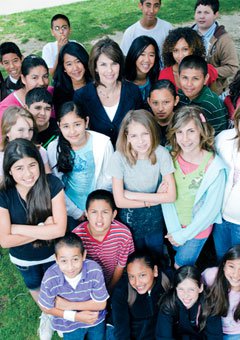How to Use Service Learning to Engage Kids
Six strategies for starting meaningful community-service projects.

This how-to article accompanies the feature "Rural Students Reap Academic Gains from Community Service."
Integrating service-learning projects into your curriculum doesn't have to add hours to your planning time, and these projects deliver a big payoff for students. Fowler Unified School District teacher Monica Sigala urges her colleagues to begin with a short project. "Just start small and let it grow," says the teacher of grades 6-7. "Don't fear it, because service learning creates the type of kids who know they can make a difference in a life or in the world." Sigala and fellow Fowler teacher LeAnn Hodges share their strategies:
Let the Kids Identify a Need
Many teachers have students interview members of their family and community to find out what problems are in need of tackling and what resources are available. Real needs can also be identified through student journal assignments and classroom discussions. Hodges asks her third graders, "Is there a poverty problem? Is there a graffiti problem? What are the needs in our community?"
Use Current Events
She also suggests studying current events to help identify needs. Her students once developed a service-learning project around helping families affected by a major Central Valley citrus freeze, both because many of their family members were field workers and because they were regularly reading the local newspaper as a class to find out what was going on in their community. Once students identify needs, she says, project ideas develop organically.
Involve Students in Decision Making and Project Design
After students brainstorm project ideas, Sigala leads them through planning with the following questions: What's the purpose of the project? Who will benefit? What steps will we need to take (writing letters, finding community donors)? What background research do we need to do? "The class fullheartedly buys into the project," she says, "because it is something they created. Without knowing it, they are learning the standards in a cooperative-learning environment."
Start Small and Local
Hodges recommends that teachers new to service learning create a two-week project. "What's a need at your school? If you have students who can't afford pencils, you can do a pencil drive," she says.
After students identify a need and a way to address it, the teacher can determine curricular ties. With a pencil project like this, Hodges would teach math (having students create graphs and charts comparing the numbers of pencils they collect with their goal) and tie in language arts by assigning letter writing and journal keeping to students summarizing their experiences.
Other short-term projects Hodges recommends include collecting and counting cans of food for two weeks before donating them to a food pantry and writing letters to local nurseries asking them to donate plants. She also suggests that students can study how the plants grow and stay healthy, and they can determine optimum locations while charting their growth. Students can also work on creating a brochure, a play, or a video to welcome incoming students to the school.
Don't Fret Over Addressing Academic Standards
"Tying in the standards is actually the easiest part," says Hodges. Both she and Sigala work with students to create a project before identifying academic skills to integrate. After she and her class have outlined the project, Sigala sits down with her standards and applies the ones that fit.
"Amazingly, the standards just start popping up all over the project," she says. "Rarely have I ever had to get too creative in matching standards to project objectives."
Look for Opportunities to Make Learning Connections
Hodges advocates using service projects as content for developing skills. "I try to tie in mini-lessons with projects," she says. After teaching adjectives to her third graders, Hodges had students use them in conjunction with a class trout-raising project by writing sentences describing the trout at different stages of their life cycle.